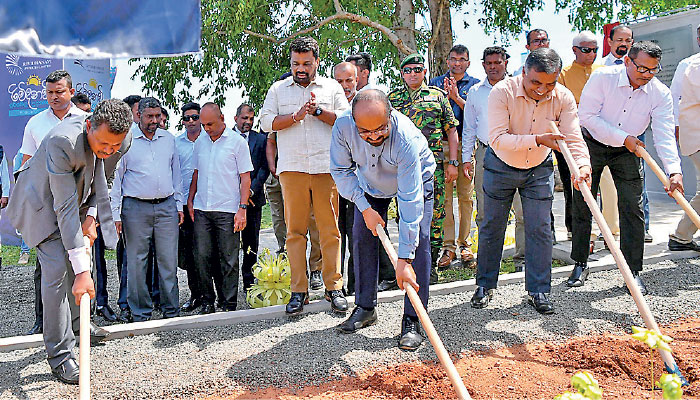Friday Dec 12, 2025
Friday Dec 12, 2025
Monday, 8 September 2025 03:02 - - {{hitsCtrl.values.hits}}

The Government began construction of the country’s largest renewable energy project—the ‘Rividanavi’ Solar Power Park on Saturday (6), under the patronage of President Anura Kumara Disanayake.
Spanning 500 acres in Kotiyagala, Monaragala District, the $ 140 million project is set to add 100 MW of clean energy to the national grid, as a key step towards achieving the target of fulfilling 70% of the country’s electricity demand from renewable energy by 2030.
This is the first project for which the Sustainable Energy Authority (SEA) has provided the project site, access roads, and all relevant approvals to the investor.
Sri Lanka’s annual electricity consumption stands at around 15,000–16,000 GWh. Through this project, 219 GWh will be added to the national grid each year. Consequently, the country will be able to save foreign exchange worth Rs. 21 billion annually, which would otherwise be spent on diesel imports for power generation. On average, this translates to a foreign exchange saving of Rs. 41 million per acre.
The Rividanavi project, which marks a milestone in the country’s sustainable development and renewable energy sector, is also expected to reduce annual carbon dioxide emissions by about 150,000 metric tons.
As the project also includes a 12 MWh battery storage facility, it is expected to provide strong support in maintaining stability within the national electricity system.
In addition to the solar power park, a new 132 kV transmission system stretching 27 kilometres will be constructed to connect the generated electricity to the grid. This will be the first power project in the country where the investor builds the transmission system. A new 132 kV grid substation is also to be established in the Monaragala area.
The project will be built according to international standards and is being implemented by ‘Rivi Danavi,’ a private company, jointly established by Lakdhanavi Ltd., and WindForce PLC. Work on the project is scheduled for completion in the first quarter of 2027, enhancing Sri Lanka’s energy independence and security.
In addition, several regional infrastructure development initiatives—new employment opportunities and social welfare projects—have been planned alongside this project. These include the ‘Rivi Nana’ scholarship program for Advanced Level students, a water supply scheme to benefit around 135 households in Kotiyagala, Akkara Seeya, and Kammalyaya affected by water scarcity, the restoration of the Muttawala (Muttakandiya) reservoir, and the provision of facilities to upgrade the Industrial Electrical Engineering Technician course at the Sri Lanka Vocational Training Authority in Ethimale up to NVQ Level 4, among other programs.
Energy Minister Kumara Jayakody stated that this project marks a transformation in the country’s energy sector.
He further pointed out that the initiative demonstrated the Government’s policy of encouraging and supporting investors in a practical manner.
Noting that the project is being advanced with investor support and expertise in line with the Government’s policy on energy security, the Minister stressed that the administration is one that proves its words through action and is dedicated to ensuring the independence and security of the country’s energy sector.
Sri Lanka Sustainable Energy Authority (SLSEA) Chairman Prof. Wijendra Bandara said that Sri Lanka possesses ample resources capable of ensuring energy independence.
He highlighted that by making optimal use of these resources, it is possible to achieve both energy independence and security.
Prof. Bandara explained that, under the prevailing procedures, approval must usually be obtained from about 12 institutions for such a project. However, during the past six to nine months, the Presidential Secretariat, together with various State institutions, provided significant support to expedite the process.
The SLSEA Chairman added that he is prepared to work with the Government and propose a streamlined procedure under one roof to accelerate such approvals for investors in the future.
The event was also attended by Uva Province Governor Kapila Jayasekara, Trade, Commerce and Food Security Deputy Minister R.M. Jayawardena, and MP Ajith Agalakada, along with local political representatives, the Monaragala District Secretary, and officials from the Ceylon Electricity Board and SLSEA.